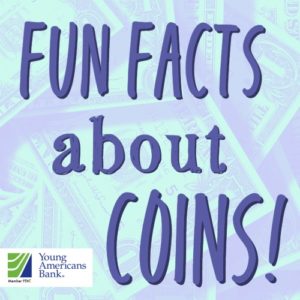Share This Article
Do you know why there are ridges on the edges of coins?
Coins have ridges to prevent counterfeiting. For centuries, coins were made of gold and silver. Criminals would carefully file shavings from the sides of coins and sell the precious metals.
While illegal, it was difficult to catch because coins were irregularly shaped due to crude manufacturing methods.
To prevent this from happening, the U.S. Mint added reeded (ridged) edges to coins. There are 118 ridges on dimes, 119 on quarters, 150 on half dollars, and 133 on Susan B. Anthony dollar coins.
Of course, none of the coins produced today contain any precious metals but the ridges are still being added to the coins because it’s a useful feature for the visually impaired.
Other interesting facts about coins:
1) The bison that appears on the Buffalo nickel lived in New York City around the turn of the 20th century. His name was Black Diamond and his official home was at the Bronx Zoo.
2) Before there were police guarding the Mint, there was a watchdog. Records show that a dog was purchased for $3 to protect the first Mint in Philadelphia.
3) The first batch of coins produced by the Mint (totaling $111.78) went into circulation in March 1793. It consisted of 11,178 copper cents.
4) The nickel’s name is unique as it’s the only U.S. coin that is called by its metal content—even though the metal alloy in a nickel is only 25 percent nickel. The rest is copper.
5) Most coins made at the United States Mint get a mint mark—a letter code that shows which branch struck the coin. Philadelphia doesn’t always use a mark because it was the first branch. And no marks were used in 1965 through 1967. But today, most coins except Philadelphia’s have mint marks on the back. One mint mark was actually recycled. Denver’s “D” used to stand for “Dahlonega” (Georgia), a branch that closed during the Civil War.
6) The United States Mint makes more coins and medals by far than any other mint in the world. We have made not only our own coins, but coins for some other countries as well.
7) George Washington was our first President – but not the first President on a circulating coin. In 1909, President Lincoln appeared on a one-cent coin and became the first real person—as well as the first American president—to have his face appear on a regular-issue American coin.
8) The first coin to feature an African-American was the Booker T. Washington Memorial Half Dollar. It was minted from 1946 to 1951.
At Young Americans Bank we like coins so much that we have a coin counting machine at our Cherry Creek branch, and it’s free for account holders! Kids can dump the contents of their piggy banks into the machine and watch as it calculates the total of all the coins they’ve saved.
Stop by for a visit to open an account, see the machine in action, lift $50 worth of coins, and determine how many coins tall you are!



